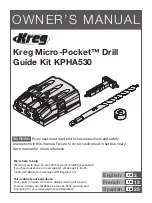
08/19/16
• Never attempt to modify the torch construction and never use unapproved accessories or fuels.
• Treat the torch as you would any fine tool or instrument. Do not drop, throw, or otherwise abuse.
• Do not use a leaking, damaged or malfunctioning torch.
• Always wear safety glasses, protective gloves and use proper tools to handle hot work.
• Radiant energy can harm your eyes. Wear glasses having an appropriate lens shade number (see 29 CFR 1926.102)
for the torch operation being done; brazing and light cutting (3 or 4), medium cutting and light welding (4 or 5), heavy
cutting and medium/heavy welding (5-8).
• Work only in well-ventilated areas. Avoid the fumes from fluxes, lead-based paint, and all metal heating operations.
Be careful to avoid fumes from cadmium plating and galvanized metal- remove these coatings in the area to be heated
by filing or sanding prior to heating.
• Never use torch to strip lead paint.
• Be careful when using the torch outdoors on sunny or windy days. Bright light makes it difficult to see the torch’s
flame. Wind may carry the torch’s heat back towards you or other areas not intended to be heated. Windy conditions
may also cause sparks to be blown into other areas with combustible materials.
• Heating a surface may cause heat to be conducted to adjoining surfaces that may be combustible or become
pressurized when heated. Always check to make sure no unintended parts or materials are being heated.
• Be aware that the tip of the torch can get extremely hot during use. Take precautions to protect yourself and others
from accidental burns.
• Never use the torch on or near combustibles. Be careful around motor vehicles or any gasoline-fired products and
beware of hidden fuel lines and tanks.
• Always make certain the torch is placed on a level surface when connected to the fuel cylinder to reduce the risk of
accidental tip over. Be sure the torch is not pointed in a direction which could cause nearby objects to ignite when the
torch is set down.
• Be careful not to overheat surrounding materials. Use a heat shield when necessary.
• Never leave the torch unattended when lit.
• Never attempt to repair or heat a gasoline tank, a chemical drum, an aerosol can, a compressed gas container that
held flammable liquid or gas or any other chemical. Heating these is extremely dangerous, especially after they have
been emptied because vapors may still be in the container.
• Always have a fire extinguisher and a bucket of water near the torch and work area.
• This torch consumes oxygen and must only be used in well ventilated areas. Do not use in a confined space.

























